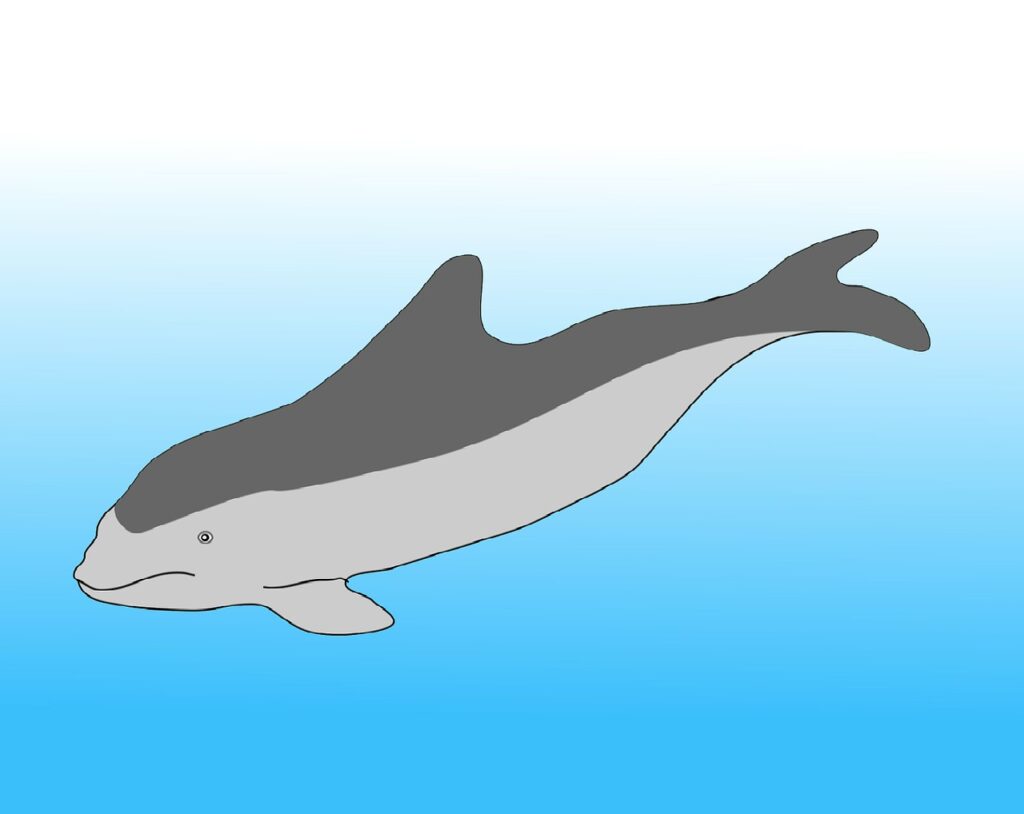Are porpoises dolphins? Clarification is needed. Both mammals belong to the same family, although there are differences. Porpoises are smaller and have shorter beaks. Teeth are different too; porpoises have spade-shaped teeth whereas dolphins have cone-shaped teeth.
Porpoises tend to be more reclusive and prefer solitude, whereas dolphins are known for their sociable and playful behavior. Additionally, they have different diets. Porpoises mainly feed on fish, while dolphins feed on fish, squid, and other small marine creatures.
To tell them apart, take a look at size, beak shape, tooth structure, behavior, and feeding habits. This will help you spot the unique characteristics that set porpoises and dolphins apart.
Key Takeaways
- – Porpoises are not dolphins, although they are often confused with each other due to their similar appearance.
- Both porpoises and dolphins belong to the same family, but they are different species.
- Porpoises are generally smaller in size compared to dolphins and have a stockier body shape.
- Dolphins are known for their playful behavior and are often seen riding the bow waves of boats, while porpoises are more shy and tend to avoid human interaction.
- Porpoises have a shorter snout and a smaller mouth compared to dolphins.
- Dolphins have a curved dorsal fin, while porpoises have a triangular or slightly curved dorsal fin.
- Porpoises are usually found in colder waters, while dolphins are more commonly found in warmer tropical and subtropical regions.
- Both porpoises and dolphins are highly intelligent marine mammals and are known for their social behavior and communication skills.
- Understanding the differences between porpoises and dolphins is important for conservation efforts and ensuring the protection of these species.
Definition and characteristics of porpoises and dolphins

Porpoises and dolphins – two marine mammals with distinct characteristics. They belong to the same family, Delphinidae, but porpoises have their own subfamily, Phocoenidae. Dolphins are known for being playful and friendly around humans, while porpoises tend to be shy and more reserved.
Size-wise, dolphins are bigger, ranging from 6 to 12 feet long. Porpoises are smaller, usually 4 to 7 feet in length. Plus, their dorsal fins differ; dolphins have curved fins, whereas porpoises have triangular ones that are smaller.
Behaviour-wise, porpoises swim alone or in small groups, while dolphins form larger pods. Also, dolphins communicate through clicks, whistles and body movements, but porpoises make fewer sounds.
Both use echolocation to navigate and locate prey underwater, sending out sounds and listening for echoes. This helps them create mental maps and detect food sources.
Key similarities between porpoises and dolphins

Porpoises and dolphins have many similarities, from appearance to habitat. Porpoises have chunkier bodies and no pronounced beak. They are shy and reserved in nature. Usually found in colder waters and shallow coastal areas. Dolphins, on the other hand, have sleek bodies and a prominent beak. They are playful and social. Commonly seen leaping in tropical or temperate oceans.
Although both species share key characteristics, there are some unique features too. Porpoises usually travel in small pods of a few individuals, while dolphins form larger groups of dozens or even hundreds. Porpoises tend to be shyer and maintain a greater distance from humans than dolphins, who often display curiosity and approach boats.
To ensure minimal disturbance and make the most out of encounters with these amazing creatures, it’s important to remember a few rules:
- Minimize noise
- Maintain distance
- Avoid feeding
- Practice responsible boating
That way, we can appreciate their beauty while ensuring their well-being and conservation.
Key differences between porpoises and dolphins

To better understand the distinctions between porpoises and dolphins, delve into the key differences between them. Explore their physical characteristics, their habitat and behavior, as well as their communication and social behavior. Each sub-section provides valuable insights into what sets these two marine creatures apart.
Physical characteristics
Porpoises and dolphins may look alike, but they have distinct physical characteristics. Let’s explore them! Check out this table for key differences between these two creatures:
| Characteristics | Porpoises | Dolphins |
|---|---|---|
| Size | Generally smaller | Vary in size, some are large (like the Orca) |
| Snout Shape | Shorter and blunter | Longer and more pointed |
| Dorsal Fin Shape | Triangular, broad base | Curved or hooked, often taller |
| Tooth Structure | Small with flattened cusps | Long and sharply conical |
Porpoises have another unique feature – their bodies are stockier and rounder than dolphins.
I had a beautiful, magical encounter with a pod of dolphins. I was sailing, admiring the sun’s reflection on the ocean. Suddenly, a group of playful dolphins jumped and dove alongside the boat. It was so impressive, highlighting their agility and strength.
It’s like choosing between a lively dolphin and a shy porpoise – it’s all just water under the bridge!
Habitat and behavior
Porpoises and dolphins have different habitats and behaviors. Porpoises prefer colder waters, while dolphins are more comfortable in the tropics. Porpoises are shy, while dolphins are playful. Plus, porpoises have small, blunt snouts, while dolphins have long snouts which help them with echolocation.
An amazing thing happened recently: a pod of dolphins saved a stranded seal pup by guiding it back to deeper water. This shows how intelligent and compassionate these creatures are.
Porpoises are the introverts of the sea, while dolphins are the life of the party!
Communication and social behavior
Porpoises and dolphins differ in their communication and social behaviors. Porpoises are known for their limited vocal repertoire, shyness, and solitariness. They use echolocation to communicate. And they show less playfulness.
On the other hand, dolphins possess vast vocal repertoire, are sociable, and form strong bonds. They vocalize for various purposes. Plus, they are highly playful and exhibit extensive play behaviors.
A good example of their contrasting behavior is the synchronized swimming by a pod of dolphins in a marine research center. They vocalized and communicated with each other, showcasing their social bond and love for play.
These differences in communication styles and social behaviors of porpoises and dolphins demonstrate the diversity of marine life. Understanding these dissimilarities helps us appreciate their remarkable capabilities and adaptability in different oceanic environments.
Scientific evidence and classification
| Species | Common Name | Scientific Classification |
|---|---|---|
| Tursiops truncatus | Bottlenose Dolphin | Animalia, Chordata, Mammalia, Cetacea, Delphinidae |
| Delphinus delphis | Short-beaked Common Dolphin | Animalia, Chordata, Mammalia, Cetacea, Delphinidae |
Porpoises, although they have a fancy name, are just water-bound hipsters trying to fit in with dolphins.
Frequently Asked Questions
Q: Are porpoises dolphins?
A: No, porpoises are not dolphins. Although both are mammals and belong to the same family, they are different species.
Q: What is the main difference between porpoises and dolphins?
A: The main difference lies in their physical characteristics. Porpoises are generally smaller in size, have a more robust body shape, and possess a rounded head, while dolphins have a slender body, a prominent beak, and a larger size.
Q: Can porpoises and dolphins interbreed?
A: No, porpoises and dolphins cannot interbreed. They have different mating behaviors and their genetic differences prevent them from producing viable offspring.
Q: Are porpoises as intelligent as dolphins?
A: While both porpoises and dolphins are highly intelligent marine mammals, dolphins are generally known to be more socially complex and exhibit higher cognitive abilities compared to porpoises.
Q: Do porpoises and dolphins have similar behavior and habits?
A: Porpoises and dolphins exhibit some similarities in their behavior and habits, such as their social nature, strong communication skills, and playful nature. However, there are specific behavioral differences unique to each species.
Q: Are porpoises and dolphins equally threatened by human activities?
A: Unfortunately, both porpoises and dolphins face threats from various human activities, including pollution, habitat destruction, fishing practices, and noise pollution. Conservation efforts are crucial to protect both species.
Conclusion
Porpoises and dolphins – are they the same? It’s an intriguing question. Although similar in appearance and habitat, there are differences. Porpoises have shorter snouts and different teeth, while dolphins have elongated snouts and cone-shaped teeth. And dolphins often play with people, but porpoises often avoid them. These details help us understand the wonderful world of marine life and its diversity.
Protecting these animals is important. We need to learn more about them, spread the word about conservation, and promise to keep them safe.
Exploring porpoises and dolphins is an ongoing journey. New things to learn are around every corner. The ocean holds many mysteries, urging us to never stop searching.
References




